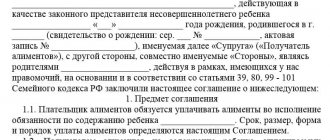Is it possible to increase the amount of alimony?
A change in alimony up or down is possible with a decrease or increase in earnings, changes in the financial or marital status of the recipient. Other grounds provided for by law are also taken into account.
Grounds for collecting additional alimony
Grounds for increasing alimony:
- A sharp decrease in the recipient's income. The legislation puts the interests of minors first. If the established alimony is not enough for the maintenance and optimal nutrition of the child, the court may order an increased amount of payments or change the method of payment - change the share to a fixed amount or vice versa. It all depends on which one turns out to be more profitable and on the claims.
- Job loss. The recipient may be laid off, which will leave him and his child without finances for some time. If a woman is caring for a disabled child and is recognized as needy, she will be able to collect alimony for herself. If the recipient voluntarily resigns, the claim to increase the amount of alimony will most likely be rejected.
- An increase in prices for goods and products with the same amount of the recipient’s salary, if indexation is not proportional to the increase in product costs.
- A serious illness due to which a woman is unable to work and lacks funds to support a child or the need for expensive medications and treatment.
- Death of close relatives who helped the claimant financially at the same time as the payer, if this resulted in a deterioration in financial well-being.
- If there are the following reasons, the plaintiff can additionally recover funds for himself: pregnancy or raising a child under 3 years of age, established need when caring for a disabled minor; disability acquired during marriage or within a year after divorce; neediness and reaching pre-retirement age within 5 years after divorce.
Among the main reasons is the appearance of a second child for the claimant, but the legislation interprets this situation unambiguously: only his parents are responsible for each minor, and if the child is not related to the payer, he is not obliged to support him, nor is he obliged to pay increased alimony.
The above options are relevant for collecting additional alimony.
Ways to increase basic alimony
You can increase the amount of alimony in the following ways:
- Changing share payments to fixed ones and vice versa, if after calculation the plaintiff determines that another option is more profitable for him.
- On the grounds stated earlier, if the amount of payments is less than regulated by law.
It is important to take into account that when payments are made as a percentage of the salary, the amount cannot be more than established by Art. 81 IC RF. It is easier to increase fixed alimony payments.
Appealing a court decision
If one of the parties does not agree with the decision, it can be appealed within a month by filing an appeal, and later only through a cassation appeal.
The appeal is submitted to a higher judicial authority. For example, if a decision is made by a magistrate's court, an appeal is made to the district court.
Procedure:
- The interested party files an appeal.
- The court receives the appeal and notifies all parties to the proceedings, including the defendant in this case.
- The defendant has the right to file an objection. If it is reasoned, the court will take it into account.
- The judicial authority issues an appeal decision. If it changes or cancels the terms of the first decision, it enters into legal force on the day of execution.
Filing a claim to increase the amount of alimony is available to both parties – the payer and the recipient. You can increase the amount of payments by drawing up an alimony agreement, and if there are disputes, only in court.
Increase in alimony by method of assignment
There are three assignment methods:
- in a fixed amount;
- as a share of salary;
- in a mixed form (implies payments in interest and a fixed amount at the same time).
In a fixed amount of money
Fixed amounts are beneficial if the payer’s earnings are low. For example, with an income of 15,000 rubles. the child will receive 3,750 rubles, which does not reach half the subsistence level in most constituent entities of the Russian Federation.
There is also a downside: if the payer’s salary is 15,000 rubles, assign payments of 10,000 rubles. changing the method of collection will not work, because the man will not have enough means of subsistence. His interests are also taken into account.
In this case, the court will be guided by the need and financial situation of the parties. If the payer earns enough to bring the amount of alimony to the minimum level for the child’s living, the claim will be satisfied.
In percentages
Here the situation is the opposite: a claim to change the method of payment from a fixed sum to a shared one is beneficial when the amount of existing payments is less than the amount required under the claim.
Example from practice: Officially, a man earns 70,000 rubles, but when alimony was assigned, his earnings were 10,000 rubles, payments were assigned in a fixed amount - 2,500 rubles. monthly. A year later, the salary increased to the specified level, the method of collection remained the same. The ex-wife filed a lawsuit to change the method, the court satisfied it, assigning alimony - 25% of income, or 17,500 rubles.
Mixed
This option is relevant when the payer has a main official income and an additional one, but the exact amount cannot be determined. Shared alimony may be prescribed for a set salary, and fixed alimony for other earnings.
Amount of alimony
Amount of alimony for children from different marriages
Reasons for refusing to accept an application
It should be remembered that the acceptance of a claim and a negative decision on it are two different things. A claimant may be refused admission when:
- an incomplete list of documents has been provided;
- there are no grounds for increasing payments;
- The submitted documents do not correspond to state standards.
A negative decision can be made for reasons: deterioration of solvency, financial problems or the normal financial situation of the plaintiff.
How to file a claim for an increase in alimony?
Procedure for going to court:
- A package of documents is being collected. Certificates confirming the need for increased payments will be required. If the method of collection changes, confirmation of the plaintiff’s need is not necessary.
- A statement of claim is drawn up and submitted to the court along with the documents.
- The parties receive notification of the appointed date of the court hearing - it arrives in writing or via SMS.
- Hearings are being held. The judge takes into account all the circumstances to make an objective decision. If it is determined that the plaintiff does not need increased payments or the defendant earns too little, the claim will be partially satisfied or rejected.
- The plaintiff receives an extract from the court decision and a writ of execution. The IL is transferred to the bailiffs or to the payer’s place of employment.
Claims are considered individually and must be supported by documentary evidence. Even if the plaintiff has a really bad financial situation, this does not guarantee the satisfaction of the claim: it may turn out that the defendant earns less and he himself does not have enough money to live.
Who can apply?
Depending on the specific situation, the following may go to court:
- biological parents of the child,
- guardians or adoptive parents,
- child protection.
Most often, the initiators of going to court are recipients of alimony, but payers can also apply for an increase if:
- Previously, they had child support obligations to other children, but now they have been stopped and they have the opportunity to pay more
- Additional income appeared: from renting out an apartment, making a profit from valuable deposits, etc.
Documents attached to the claim
When filing a claim you will need:
- passport;
- certificates of registration and divorce;
- children's birth certificates;
- salary certificates;
- work book if the plaintiff is laid off due to layoffs and needs financial support.
The court clerk makes copies of the documents, and the originals are given to the owner.
The validity period of the writ of execution for alimony lasts until the child reaches adulthood.
Arbitrage practice
Judicial practice in cases of increasing alimony is ambiguous: the court’s decision directly depends on the circumstances that the parties appeal to when considering the case. For example, the decision of March 16, 2017 in case No. 02-0054/419/2017:
The plaintiff went to court with a request to change the amount of payments from shared to fixed, since the defendant constantly changes his place of work, which infringes on the interests of the child. The claims indicate the establishment of alimony at the subsistence level for the region. The defendant is not officially employed and is registered as unemployed.
Having studied the circumstances, the court decided to assign mixed payments: a share will be withheld from the benefits, a fixed amount - from the total additional income - the defendant did not deny their existence. The claim was partially satisfied, the defendant was ordered to pay 12,989 rubles. total.
Attachments to the claim
The application will not be considered without attachments justifying its submission. The list includes documents:
- copies of claims according to the number of parties involved in the process;
- receipt of payment of state duty;
- applicant's passport;
- a document confirming the right of a family member (child, parent) to receive alimony;
- a document providing the basis for payment of alimony: an agreement, a court order, a court decision, that is, a writ of execution with information about the previous amount of payments;
- copies of documents confirming receipt of penalties;
- documents confirming the reasons for the need to increase alimony: a certificate of health, a change in family composition, admission to an educational institution on a paid basis, checks indicating the cost of medications for health improvement and other evidence.
If the required documents are not available, the applicant will be given time to collect data.
Special cases of increasing alimony
For a detailed analysis of the features of changing the amount of alimony, it is enough to familiarize yourself with practical examples.
Increase in alimony when the payer’s salary is gray
Gray wages are wages where part of the earnings is officially listed according to documents, and part is given to the employee and does not appear anywhere. As a rule, unofficial payments significantly exceed the official amount.
In such a situation, the claimant will have to prove the fact of gray earnings by contacting the tax service with a request to conduct an audit, and also take official data on the average salary in the region from Rosstat.
Example from practice: Petrova O.N. is raising a 10-year-old daughter. She was given alimony in the amount of 25% of her father's earnings. He is employed in an LLC, officially earns 15,000 rubles, unofficially – 80,000 rubles.
To increase the amount of payments, O.N. Petrova requested a salary certificate from the accounting department at her ex-husband’s place of work. They contained only official data. Then the woman appealed to the Federal Tax Service with a complaint about the taxpayer’s employer violating Tax legislation.
The audit revealed that the payer actually received unofficial income. Petrova O.N. asked for copies of the conclusion and resolution on bringing to administrative responsibility in order to use them as evidence. A request was also made to Rosstat.
According to statistics, the average salary by profession of a defendant in the region is 60,000 rubles. This amount was used to calculate alimony.
In her claims, the woman petitioned for the establishment of fixed payments at the subsistence level - 12,500 rubles. After studying the documents and arguments, the claim was granted.
Increase in alimony if the payer is disabled
It is problematic to request an increase in alimony from payers on disability - they themselves need financial support. Here it is possible to recover additional expenses for the maintenance of children:
Agapova L.D. has a 12-year-old son. In 2021, he was involved in an accident, the driver was ordered to pay compensation, but it was not enough for treatment. Then the woman decided to collect additional funds from her ex-husband, a group 2 disabled person. Over the course of 2 months, she collected checks and receipts for a total of 50,000 rubles. In court, she demanded to recover 50% of the expenses from the man, i.e. 25,000 rubles.
The payer's disability pension is 9,500 rubles, of which 2,375 rubles. He pays monthly in the form of alimony. The claim was satisfied, the man was obliged to compensate for part of the expenses incurred for the child, but was allowed to transfer money in small monthly payments, taking into account his state of health.







